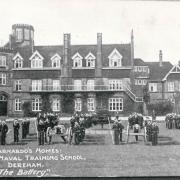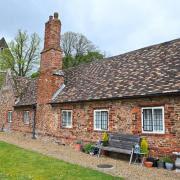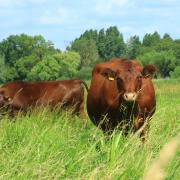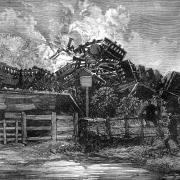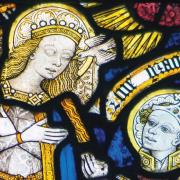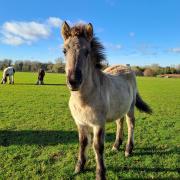Bright paintings of busy staithes, carved signs telling village stories in a shorthand of local history and legend, houses resplendent with fancy thatch and pargetted plasterwork, ornate iron weathervanes and woollen fishermen’s jumpers – all of this is folk art.
It is ships and circles scratched on church walls and rendered as centuries-old prayers for safety; it is the graffiti left by American airmen fighting the Second World War from airfields across East Anglia.
In Smiling at the Storm Norfolk historian and writer Peter Tolhurst has created a wonderfully accessible history and celebration of the art all around us.

He tells the story of the hulkingly-haunched farm animals, once the height of agricultural fashion, paraded at village shows and shown off by proud owners in specially commissioned portraits. He follows sailors whiling away long trips on whaling ships by etching detailed drawings into whales’ teeth.
He describes folk art as lifting something functional – clothing, pottery, transport, buildings – out of the ordinary. Its paintings are not made for the ‘fine art’ space of a gallery but record everyday scenes, often by and for everyday people. It embraces the embroidered millennium maps made in Norfolk villages at the turn of the 21st century and the Norwich Cathedral roof bosses made many hundreds of years ago to tell the entire bible in brightly-painted stone carvings.
Peter seeks out the gloriously colourful art of pub signs, and of our surprisingly recent village signs. He finds artists John Crome and Alfred Munnings, not yet famous, painting Norwich factory advertisements and pub signs. And he tells the story of village signs, born on the Sandringham estate barely a century ago and enthusiastically adopted by neighbouring counties.

Counties shaped by the sea were once also awash with carved figureheads for ships, fishermen’s jumpers which were both elaborate and practical, and painted, carved and embroidered boats.
‘I've always been a huge admirer of the retired fisherman John Craske and his wool pictures - a fine example of 'outsider' art, as are the extraordinary needlework letters of Lorina Bulwer,’ said Peter.
He tells the tragic and astonishing story of Lorina who, confined to a Great Yarmouth asylum, expresses her stream-of-consciousness fury in embroidered invective. ‘I HAVE WASTED 10 YEARS IN THIS DAMNATION HELL FIRE TRAMP DEN OF OLD WOMEN OLD HAGS,’ and ‘SHE IS AN IMPOSTER FORGER DEFRAUDER’ she rages across off-cuts of fabric filled with insults, complaints and angry fighting figures.

John Craske also struggled with his mental and physical health and also used embroidery to express himself, creating magnificently detailed seaside scenes.
Smiling at the Storm; East Anglian Folk Art is alive with such stories, weaving in corn dollies, scarecrows, fancy farm carts, fairground rides, and weathervanes sporting wolves, angels, ships and trains.
‘There are no better examples of folk art than the gansey knitting patterns from Sheringham or the remarkable 1920s knapped flint alphabet and necklace by Bill Basham of Brandon,’ said Peter, who lives in Norwich.
‘I’ve been fascinated by the beliefs and folk art of ordinary, often unknown, people since I moved to East Anglia some 50 years ago and discovered the work of the oral historian George Ewart Evans.’

Alongside his career as a conservation officer for Breckland District Council he researched the architecture, art and folk stories of the region, eventually taking early retirement to launch a publishing venture, Black Dog Books.
His first book East Anglia: A Literary Pilgrimage, with a foreword by renowned novelist Elspeth Barker, was followed by books by authors including Ronald Blythe and Sylvia Townsend Warner, and his own beautifully-produced, impeccably researched and wonderfully accessible explorations of local landscapes, literature, churches and art.
‘More recently, looking around for a new subject I realised that there was nothing on Norfolk folklore and found a huge amount of material in the Norfolk Record Office, much of it collected by WB Gerish in the 1920s,’ said Peter. ‘Quite why he never turned it all into a book I'm not sure, but I thought I could do something with it. It has struck a chord with readers and has sold over 4,000 copies since I first published it in 2018. In much the same way there was nothing on regional folk art and Smiling at the Storm; East Anglian Folk Art seemed like a natural progression.’
As befits a book on art and design, it is itself a thing of beauty. Colour pictures gleam from every glossy page. Published by Norfolk-based Propolis, Smiling at the Storm; East Anglian Folk Art shimmers with fascinating, fabulous stories, a fine tribute to countless, often unknown and unnamed, artists and craftspeople.










